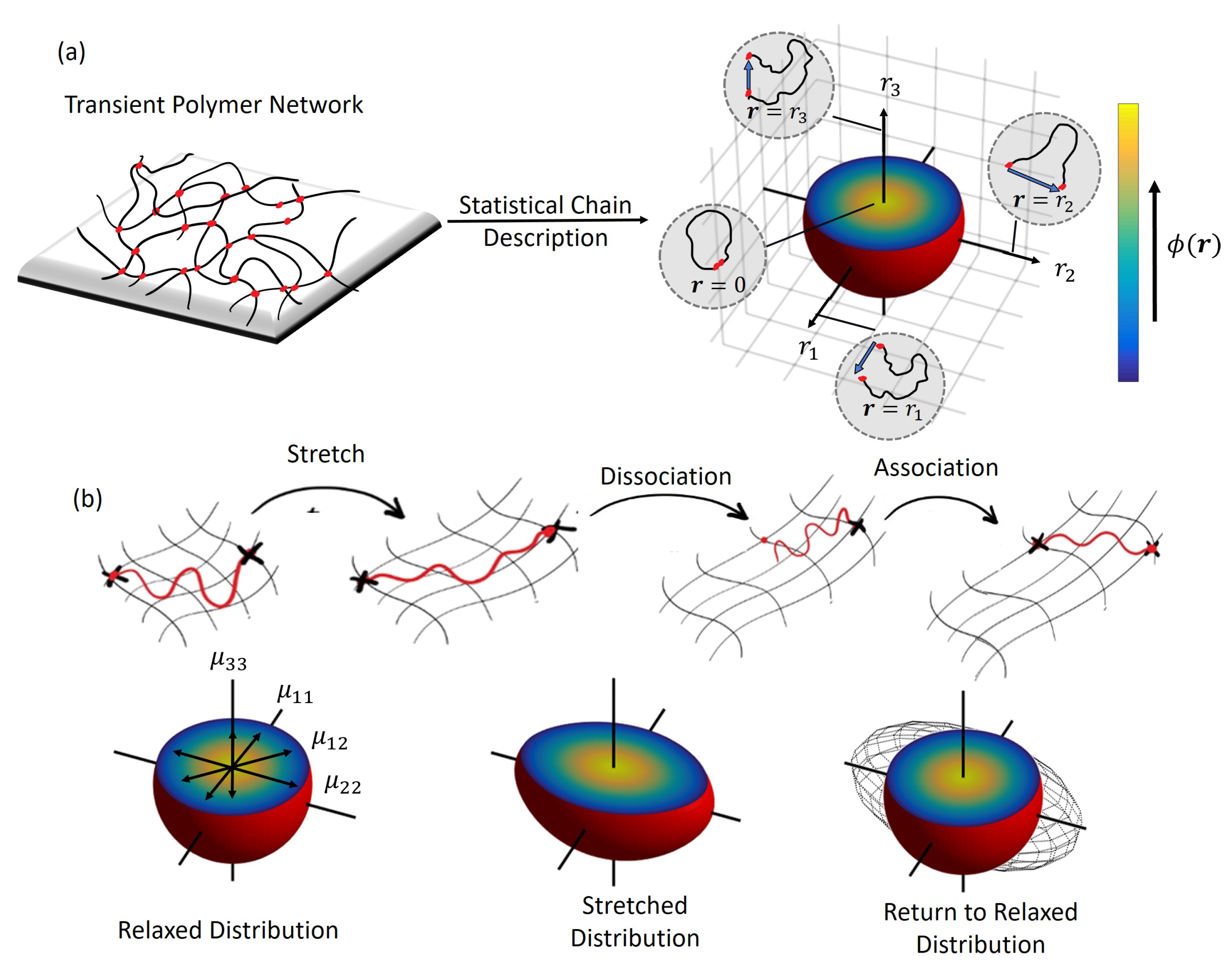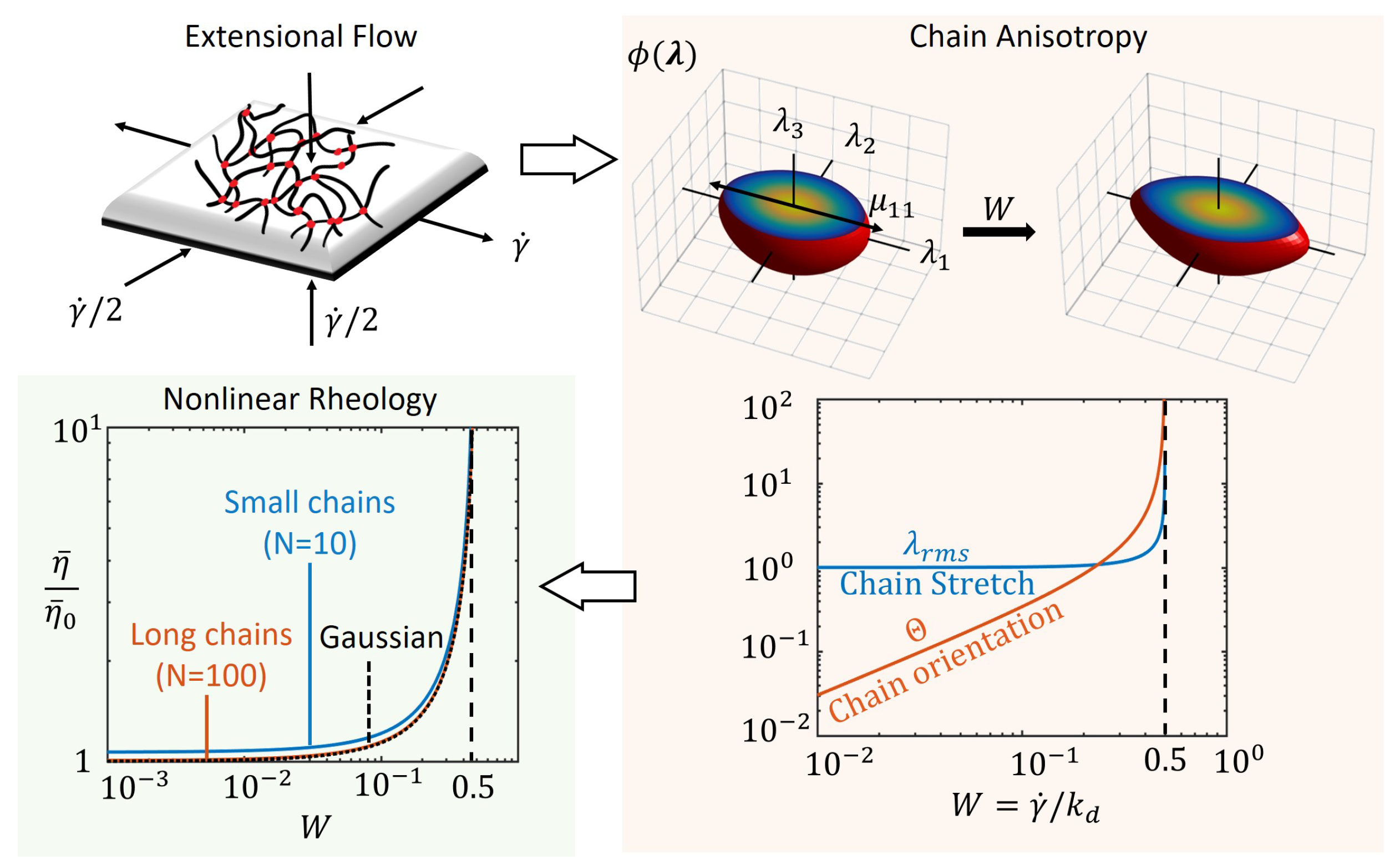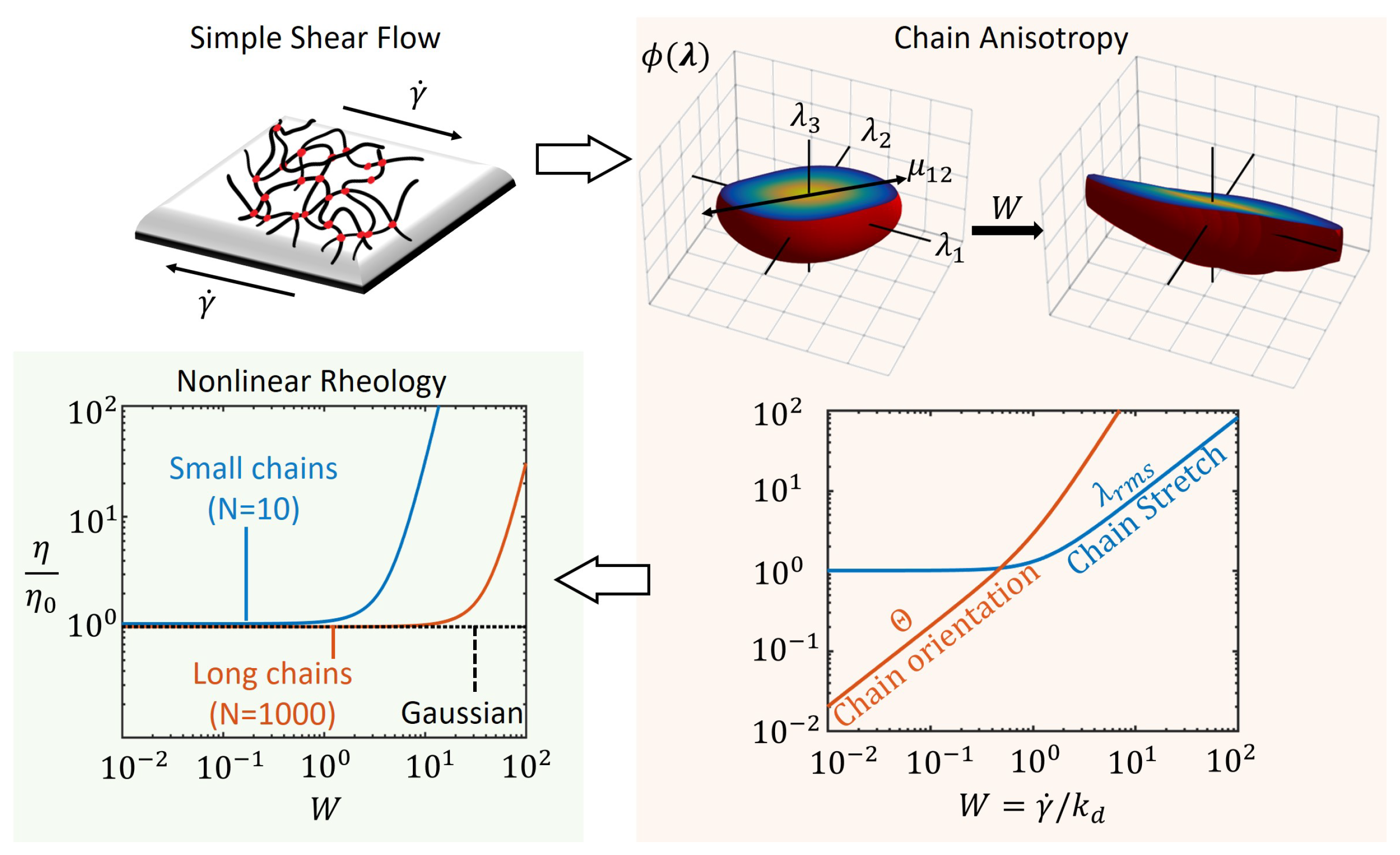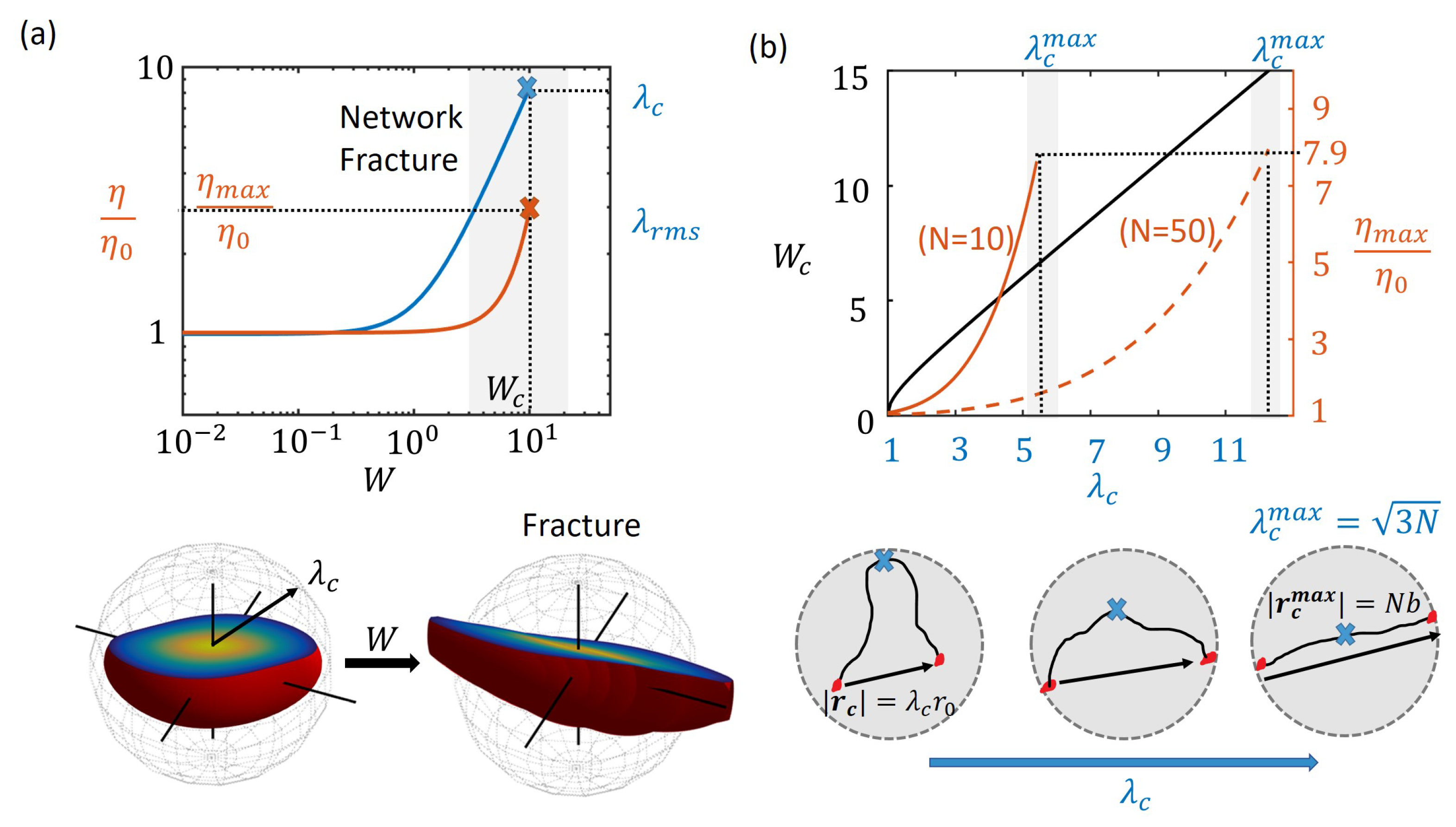The Chain Distribution Tensor: Linking Nonlinear Rheology and Chain Anisotropy in Transient Polymers
Abstract
1. Introduction
2. Transient Network Theory for Polymer Networks with Reversible Bonds
2.1. Statistical Description of Polymer Chains.
2.2. Evolution equations.
- (a)
- The rate of change of chain stretch, , due to network deformation that is governed by the macroscopic velocity gradient where: is the velocity field in the material and ∇ is the differential operator. If we assume that the chains undergo affine deformation (i.e., they follow the macroscopic deformation ), the stretch rate is given by .
- (b)
- The association of new chains into the network with rate, , at a near stretch-free configuration that follows the well-known Gaussian probability density function for polymer chains, .
- (c)
- The dissociation of attached chains that may be in a stretched state at the rate .
2.3. Macroscopic energy and stress
3. Flow Regimes under Steady Deformation Rates
3.1. Extensional Viscosity
3.2. Steady Shear Viscosity
3.3. Network Fracture at Critical Strain Rates
3.4. Viscosity at High Cross-Linker Densities
4. Conclusions
Author Contributions
Funding
Conflicts of Interest
Abbreviations
| TNT | Transient Network Theory |
| MDPI | Multidisciplinary Digital Publishing Institute |
| DOAJ | Directory of Open Access Journals |
Appendix A. Derivation of Solution for Shear Thickening Equations
Appendix B. Derivation of Friction for “Sticky” Reptation Model
References
- Green, M.S.; Tobolsky, A.V. A New Approach to the Theory of Relaxing Polymeric Media. J. Chem. Phys. 1946, 14, 80–92. [Google Scholar] [CrossRef]
- Tanaka, F.; Edwards, S.F. Viscoelastic properties of physically crosslinked networks. 1. Transient network theory. Macromolecules 1992, 25, 1516–1523. [Google Scholar] [CrossRef]
- Kramer, O. Biological and Synthetic Polymer Networks; Springer Science & Business Media: Berlin, Germany, 2012. [Google Scholar]
- Terech, P.; Schaffhauser, V.; Maldivi, P.; Guenet, J.M. Living polymers in organic solvents. Langmuir 1992, 8, 2104–2106. [Google Scholar] [CrossRef]
- Geitmann, A.; Ortega, J.K.E. Mechanics and modeling of plant cell growth. Trends Plant Sci. 2009, 14, 467–478. [Google Scholar] [CrossRef] [PubMed]
- Vernerey, F.J.; Akalp, U. Role of catch bonds in actomyosin mechanics and cell mechanosensitivity. Phys. Rev. E 2016, 94, 012403. [Google Scholar] [CrossRef] [PubMed]
- Akalp, U.; Schnatwinkel, C.; Stoykovich, M.P.; Bryant, S.J.; Vernerey, F.J. Structural Modeling of Mechanosensitivity in Non-Muscle Cells: Multiscale Approach to Understand Cell Sensing. ACS Biomater. Sci. Eng. 2017, 3, 2934–2942. [Google Scholar] [CrossRef] [PubMed]
- Wojtecki, R.J.; Meador, M.A.; Rowan, S.J. Using the dynamic bond to access macroscopically responsive structurally dynamic polymers. Nat. Mater. 2011, 10, 14–27. [Google Scholar] [CrossRef] [PubMed]
- Roy, N.; Bruchmann, B.; Lehn, J.M. DYNAMERS: Dynamic polymers as self-healing materials. Chem. Soc. Rev. 2015, 44, 3786–3807. [Google Scholar] [CrossRef] [PubMed]
- Cordier, P.; Tournilhac, F.; Soulié-Ziakovic, C.; Leibler, L. Self-healing and thermoreversible rubber from supramolecular assembly. Nature 2008, 451, 977–980. [Google Scholar] [CrossRef] [PubMed]
- Akalp, U.; Bryant, J.S.; Vernerey, J.F. Tuning tissue growth with scaffold degradation in enzyme-sensitive hydrogels: A mathematical model. Soft Matter 2016, 12, 7505–7520. [Google Scholar] [CrossRef] [PubMed]
- Bryant, S.J.; Vernerey, F.J. Programmable Hydrogels for Cell Encapsulation and Neo-Tissue Growth to Enable Personalized Tissue Engineering. Adv. Healthc. Mater. 2017, 7, 1700605. [Google Scholar] [CrossRef] [PubMed]
- Sridhar, S.L.; Schneider, C.M.; Chu, S.; Roucy, G.D.; Bryant, J.S.; Vernerey, J.F. Heterogeneity is key to hydrogel-based cartilage tissue regeneration. Soft Matter 2017, 13, 4841–4855. [Google Scholar] [CrossRef] [PubMed]
- De Greef, T.F.A.; Meijer, E.W. Materials science: Supramolecular polymers. Nature 2008, 453, 171–173. [Google Scholar] [CrossRef] [PubMed]
- Serpe, M.J.; Craig, S.L. Physical Organic Chemistry of Supramolecular Polymers. Langmuir 2007, 23, 1626–1634. [Google Scholar] [CrossRef] [PubMed]
- Seiffert, S.; Sprakel, J. Physical chemistry of supramolecular polymer networks. Chem. Soc. Rev. 2012, 41, 909–930. [Google Scholar] [CrossRef] [PubMed]
- Watanabe, H. Viscoelasticity and dynamics of entangled polymers. Prog. Polym. Sci. 1999, 24, 1253–1403. [Google Scholar] [CrossRef]
- Leibler, L.; Rubinstein, M.; Colby, R.H. Dynamics of reversible networks. Macromolecules 1991, 24, 4701–4707. [Google Scholar] [CrossRef]
- Loveless, D.M.; Jeon, S.L.; Craig, S.L. Rational Control of Viscoelastic Properties in Multicomponent Associative Polymer Networks. Macromolecules 2005, 38, 10171–10177. [Google Scholar] [CrossRef]
- Meng, F.; Pritchard, R.H.; Terentjev, E.M. Stress Relaxation, Dynamics, and Plasticity of Transient Polymer Networks. Macromolecules 2016, 49, 2843–2852. [Google Scholar] [CrossRef]
- Gold, B.J.; Hövelmann, C.H.; Lühmann, N.; Pyckhout-Hintzen, W.; Wischnewski, A.; Richter, D. The microscopic origin of the rheology in supramolecular entangled polymer networks. J. Rheol. 2017, 61, 1211–1226. [Google Scholar] [CrossRef]
- White, Z.W.; Vernerey, F.J. Armours for soft bodies: How far can bioinspiration take us? Bioinspir. Biomim. 2018, 13, 041004. [Google Scholar] [CrossRef] [PubMed]
- Larson, R.G. The Structure and Rheology of Complex Fluids; Oxford University Press: Oxford, UK, 1999; Volume 150. [Google Scholar]
- Tripathi, A.; Tam, K.C.; McKinley, G.H. Rheology and Dynamics of Associative Polymers in Shear and Extension: Theory and Experiments. Macromolecules 2006, 39, 1981–1999. [Google Scholar] [CrossRef]
- Yount, W.C.; Juwarker, H.; Craig, S.L. Orthogonal Control of Dissociation Dynamics Relative to Thermodynamics in a Main-Chain Reversible Polymer. J. Am. Chem. Soc. 2003, 125, 15302–15303. [Google Scholar] [CrossRef] [PubMed]
- Yount, W.C.; Loveless, D.M.; Craig, S.L. Small-Molecule Dynamics and Mechanisms Underlying the Macroscopic Mechanical Properties of Coordinatively Cross-Linked Polymer Networks. J. Am. Chem. Soc. 2005, 127, 14488–14496. [Google Scholar] [CrossRef] [PubMed]
- Berret, J.F.; Séréro, Y.; Winkelman, B.; Calvet, D.; Collet, A.; Viguier, M. Nonlinear rheology of telechelic polymer networks. J. Rheol. 2001, 45, 477–492. [Google Scholar] [CrossRef]
- Amin, D.; Likhtman, A.E.; Wang, Z. Dynamics in Supramolecular Polymer Networks Formed by Associating Telechelic Chains. Macromolecules 2016, 49, 7510–7524. [Google Scholar] [CrossRef]
- Xu, D.; Hawk, J.L.; Loveless, D.M.; Jeon, S.L.; Craig, S.L. Mechanism of Shear Thickening in Reversibly Cross-Linked Supramolecular Polymer Networks. Macromolecules 2010, 43, 3556–3565. [Google Scholar] [CrossRef] [PubMed]
- Tam, K.C.; Jenkins, R.D.; Winnik, M.A.; Bassett, D.R. A Structural Model of Hydrophobically Modified Urethane Ethoxylate (HEUR) Associative Polymers in Shear Flows. Macromolecules 1998, 31, 4149–4159. [Google Scholar] [CrossRef]
- Regalado, E.J.; Selb, J.; Candau, F. Viscoelastic Behavior of Semidilute Solutions of Multisticker Polymer Chains. Macromolecules 1999, 32, 8580–8588. [Google Scholar] [CrossRef]
- Wang, S.Q. Transient network theory for shear-thickening fluids and physically crosslinked networks. Macromolecules 1992, 25, 7003–7010. [Google Scholar] [CrossRef]
- Witten, T.A.; Cohen, M.H. Crosslinking in shear-thickening ionomers. Macromolecules 1985, 18, 1915–1918. [Google Scholar] [CrossRef]
- Marrucci, G.; Bhargava, S.; Cooper, S.L. Models of shear-thickening behavior in physically crosslinked networks. Macromolecules 1993, 26, 6483–6488. [Google Scholar] [CrossRef]
- Séréro, Y.; Jacobsen, V.; Berret, J.F.; May, R. Evidence of Nonlinear Chain Stretching in the Rheology of Transient Networks. Macromolecules 2000, 33, 1841–1847. [Google Scholar] [CrossRef]
- Ma, S.X.; Cooper, S.L. Shear Thickening in Aqueous Solutions of Hydrocarbon End-Capped Poly (ethylene oxide). Macromolecules 2001, 34, 3294–3301. [Google Scholar] [CrossRef]
- Ballard, M.J.; Buscall, R.; Waite, F.A. The theory of shear-thickening polymer solutions. Polymer 1988, 29, 1287–1293. [Google Scholar] [CrossRef]
- Yamamoto, M. The Visco-elastic Properties of Network Structure II. Structural Viscosity. J. Phys. Soc. Jpn. 1957, 12, 1148–1158. [Google Scholar] [CrossRef]
- Indei, T. Necessary conditions for shear thickening in associating polymer networks. J. Non-Newton. Fluid Mech. 2007, 141, 18–42. [Google Scholar] [CrossRef]
- Yamamoto, M. The Visco-elastic Properties of Network Structure I. General Formalism. J. Phys. Soc. Jpn. 1956, 11, 413–421. [Google Scholar] [CrossRef]
- Vernerey, F.J.; Long, R.; Brighenti, R. A statistically-based continuum theory for polymers with transient networks. J. Mech. Phys. Solids 2017, 107, 1–20. [Google Scholar] [CrossRef]
- Vernerey, F.J. Transient response of nonlinear polymer networks: A kinetic theory. J. Mech. Phys. Solids 2018, 115, 230–247. [Google Scholar] [CrossRef]
- Treloar, L.R.G. The Physics of Rubber Elasticity; Oxford University Press: Oxford, UK, 1975. [Google Scholar]
- Trouton, F.T. On the coefficient of viscous traction and its relation to that of viscosity. Proc. R. Soc. Lond. A 1906, 77, 426–440. [Google Scholar] [CrossRef]
- Lodge, A.S. Elastic Liquids: An Introductory Vector Treatment of Finite-Strain Polymer Rheology; Academic Press: New York, NY, USA, 1964. [Google Scholar]
- Vaccaro, A.; Marrucci, G. A model for the nonlinear rheology of associating polymers. J. Non-Newton. Fluid Mech. 2000, 92, 261–273. [Google Scholar] [CrossRef]
- Thomas Hu, Y. Mechanisms of shear thickening in transient guar network. J. Rheol. 2014, 58, 1789–1807. [Google Scholar] [CrossRef]
- Indei, T.; Koga, T.; Tanaka, F. Theory of Shear-Thickening in Transient Networks of Associating Polymers. Macromol. Rapid Commun. 2005, 26, 701–706. [Google Scholar] [CrossRef]
- Kersey, F.R.; Yount, W.C.; Craig, S.L. Single-molecule force spectroscopy of bimolecular reactions: System homology in the mechanical activation of ligand substitution reactions. J. Am. Chem. Soc. 2006, 128, 3886–3887. [Google Scholar] [CrossRef] [PubMed]
- Rubinstein, M.; Colby, R.H. Polymer Physics; Oxford University Press: Oxford, UK, 2003; Volume 23. [Google Scholar]





© 2018 by the authors. Licensee MDPI, Basel, Switzerland. This article is an open access article distributed under the terms and conditions of the Creative Commons Attribution (CC BY) license (http://creativecommons.org/licenses/by/4.0/).
Share and Cite
Lalitha Sridhar, S.; Vernerey, F.J. The Chain Distribution Tensor: Linking Nonlinear Rheology and Chain Anisotropy in Transient Polymers. Polymers 2018, 10, 848. https://doi.org/10.3390/polym10080848
Lalitha Sridhar S, Vernerey FJ. The Chain Distribution Tensor: Linking Nonlinear Rheology and Chain Anisotropy in Transient Polymers. Polymers. 2018; 10(8):848. https://doi.org/10.3390/polym10080848
Chicago/Turabian StyleLalitha Sridhar, Shankar, and Franck J. Vernerey. 2018. "The Chain Distribution Tensor: Linking Nonlinear Rheology and Chain Anisotropy in Transient Polymers" Polymers 10, no. 8: 848. https://doi.org/10.3390/polym10080848
APA StyleLalitha Sridhar, S., & Vernerey, F. J. (2018). The Chain Distribution Tensor: Linking Nonlinear Rheology and Chain Anisotropy in Transient Polymers. Polymers, 10(8), 848. https://doi.org/10.3390/polym10080848





